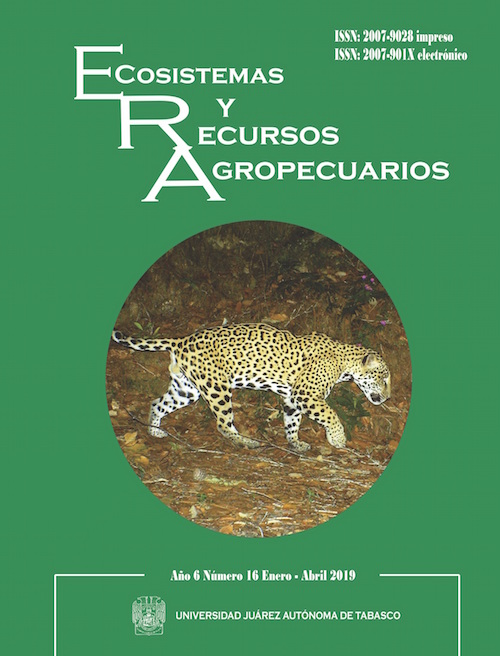Análisis in silico del gen subolesina como posible vacuna contra garrapatas Rhipicephalus microplus
DOI:
https://doi.org/10.19136/era.a6n16.1832Abstract
El objetivo del estudio fue utilizar estrategias bioinformáticas para predecir propiedades de interés del gen subolesina, así como realizar construcciones filogenéticas para identificar la relación que existe entre los aislados geográficos de garrapatas reportados en el mundo. El gen subolesina presenta 98 % de identidad entre los diferentes aislados de garrapatas R. microplus, mientras que, entre diferentes géneros (Ixodes spp., Amblyomma spp., Hyalomma spp.) fue de 77 %. Se detectaron 4 epítopos lineales de células B conservados en diferentes especies de garrapatas. El análisis de la estructura secundaria de la proteína Subolesina mostró dos α-hélices, tres regiones inespecíficas (coil) y ninguna β plegada. De los epítopos predichos, será útil demostrar su capacidad inmunoprotectora contra cepas de garrapatas R. microplus de diferentes aislados geográficos; si las regiones sugeridas son inmunogénicas, podrían ser utilizadas para el desarrollo de un inmunógeno efectivo contra poblaciones de garrapatas R. microplus.
Downloads
References
Almazán C, Lagunes R, Villar M, Canales M, Rosario-Cruz R, Jongejan F, et al. (2010) Identification and characterization of Rhipicephalus (Boophilus) microplus candidate protective antigens for the control of cattle tick infestations. Parasitology Research 106: 471–479.
Almazán C, Aguilar-Tipacamu G, Rodríguez S, Mosqueda J, Pérez de León AA (2018) Immunological control of ticks and tick-borne diseases that impact cattle health and production. Frontiers in Bioscience 23: 1535-1551.
Buchan DWA, Minneci F, Nugent TCO, Bryson K, Jones DT (2013) Scalable web services for the PSIPRED Protein Analysis Workbench. Nucleic Acids Research 41: W340-W348.
Felsenstein J (1985) Phylogenies and the Comparative Method. The American Naturalist 125:1-15.
García-García JEC, González IL, González DM, Valdés M, Méndez L, Lamberti J, et al. (1999) Sequence variations in the Boophilus microplus Bm86 locus and implications for immunoprotection in cattle vaccinated with this antigen. Experimental Applied Acarology 23: 883–895.
Gasteiger E, Hoogland C, Gattiker A, Duvaud S, Wilkins MR, Appel RD, et al. (2005) Protein Identification and Analysis Tools on the ExPASy Server. (In) John M. Walker (ed): The Proteomics Protocols Handbook, Humana Press 571–607.
Guindon S, Gascuel O (2003) A simple, fast, and accurate algorithm to estimate large phylogenies by Maximum Likelihood. Systematic Biology 52: 696–704.
Kolaskar AS, Tongaonkar PC (1990) A semi-empirical method for prediction of antigenic determinants on protein antigens. FEBS Letters 276: 172-174.
Lew-Tabor AE, Bruyeres AG, Zhang B, Valle MR (2014) Rhipicephalus (Boophilus) microplus tick in vitro feeding methods for functional (dsRNA) and vaccine candidate (antibody) screening. Ticks Tick Borne Diseases 5: 500–510.
Mahajan B, Berzofsky JA, Boykins RA, Majam V, Zheng H, Chattopadhyay R, et al. (2010) Multiple antigen peptide vaccines against Plasmodium falciparum malaria. Infection and Immunity 78: 4613-4624.
Manzano-Roman R, Diaz-Martin V, Oleaga A, Siles-Lucas M, Perez-Sanchez R (2012) Subolesin/akirin orthologs from Ornithodoros spp. soft ticks: cloning, RNAi gene silencing and protective effect of the recombinant proteins. Veterinary Parsitology 185: 248–59.
Merino O, Antunes S, Mosqueda J, Moreno-Cid JA, Pérez de la Lastra JM, Rosario-Cruz R, et al. (2013) Vaccination with proteins involved in tick-pathogen interactions reduces vector infestations and pathogen infection. Vaccine 31: 5889-5896.
Molento MB, Fortes FS, Buzatti A, Kloster FS, Sprenger IK, Coimbra E, et al. (2013) Partial selective treatment of Rhipicephalus microplus and breed resistance variation in beef cows in Rio Grande do Sul, Brazil. Veterinary Parasitology 192: 234-239.
Popara M, Villar M, Mateos-Hernández L, Fernández de Mera IG, Marina A, del Valle M, et al. (2013) Lesser protein degradation machinery correlates with higher BM86 tick vaccine efficacy in Rhipicephalus annulatus when compared to Rhipicephalus microlpus. Vaccine 31: 4728–4735.
Robbertse L, Baron S, Van Der Merwe NA, Madder M, Stoltsz WH, Maritz-Olivier C (2016) Genetic diversity, acaricide resistance status and evolutionary potential of a Rhipicephalus microplus population from a disease-controlled cattle farming area in South Africa. Ticks and Tick Borne Diseases 7: 595-603.
Rodríguez-Vivas R, Pérez-Cogollo L, Rosado-Aguilar J, Ojeda-Chi M, Trinidad-Martínez I, Miller R, et al. (2014) Rhipicephalus (Boophilus) microplus resistant to acaricides and ivermectin in cattle farms of Mexico. Brazilian Jouernal Veterynari Pasasitology Jaboticabal 2961: 113–122.
Saha S, Raghava GPS (2004) BcePred: Prediction of Continuous B-Cell Epitopes in Antigenic Sequences Using Physico-chemical Properties. In G. Nicosia, V. Cutello, P.J. Bentley and J.Timis (Eds.) ICARIS. LNCS 3239: 197-204.
Saha S, Raghava GPS (2006) Prediction of continuous B-cell epitopes in an antigen using recurrent neural network. Proteins 65: 40–48.
Shakya M, Kumar B, Nagar G, de la Fuente J, Ghosh S (2014) Subolesin: a candidate vaccine antigen for the control of cattle tick infestations in Indian situation. Vaccine 32: 3488-3494.
Sultana H, Patel U, Sonenshine DE, Neelakanta G (2015) Identification and comparative analysis of subolesin/akirin ortholog from Ornithodoros turicata ticks. Parasites & Vectors 8: 132.
Tamura K (1992) Estimation of the number of nucleotide substitutions when there are strong transition-transversion and G+C content biases. Molecular Biology and Evolution 9: 678–687.
Tamura K, Stecher G, Peterson D, Filpiski A, Kumar S (2013) MEGA6: Molecular Evolutionary Genetics Analysis versión 6.0. Molecular Biology and Evolution 30: 2725-2729.
Downloads
Published
Issue
Section
License
Aviso de copyright
Los autores que se envían a esta revista aceptan los siguientes términos:
una. Los autores conservan los derechos de autor y garantizan a la revista el derecho a ser la primera publicación del trabajo con una licencia de atribución de Creative Commons que permite a otros compartir el trabajo con un reconocimiento de la autoría del trabajo y la publicación inicial en esta revista.
B. Los autores pueden establecer acuerdos complementarios separados para la distribución no exclusiva de la versión del trabajo publicado en la revista (por ejemplo, en un repositorio institucional o publicarlo en un libro), con un reconocimiento de su publicación inicial en esta revista.
C. Se permite y se anima a los autores a difundir su trabajo electrónicamente (por ejemplo, en repositorios institucionales o en su propio sitio web) antes y durante el proceso de envío, ya que puede conducir a intercambios productivos, así como a una cita más temprana y más extensa del trabajo publicado. (Consulte El efecto del acceso abierto).

